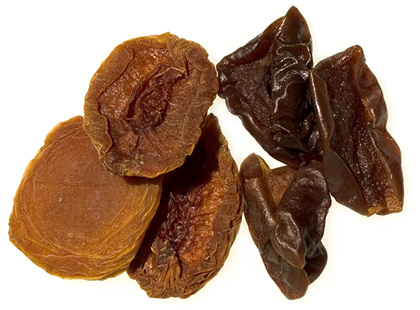History and spreading

Peaches are stone fruit. The tree reaches an average height of 5 − 7 m. Already during March the pink coloured, single growing blossoms cover the tree. The ovaries develop into fine hairy, velvet like, sweet juicy stone fruit with yellow and red.
The warmness-loving peachtree has been cultivated in China since the early times. It has spread through Persia to Europe and is nowadays cultivated in large numbers in Mediterranean countries and the United States. Main export countries for dried peaches are California, Australia, Southafrika and Argentina, and since the middle of the 90ies once more China.
Cultivation
Peach trees are grown in plantations. The distance between the trees, which reach a height between 3 – 4 m, is abt. 5 m.
After 5 years the trees carry fruit for the first time, but only in the 8th year a full yield can be expected. After 40 years the carrying capacity decreases and then the trees are cut down. The tree´s average annual yield amounts to approx. 60 kg. To get 1 kg dried peaches 5 kg of fresh fruit is needed.
Modern peach varieties (e.g. nectarines) are obtained by grafting. For this a twig of a peach tree is grafted into the trunk of a young plum tree. This has two effects. 1) the fruit will be sweeter and 2) the tree carries more fruit.
Harvest
On the northern hemisphere harvest is during July and August, on the southern hemisphere in January and February. Peaches are harvested when they are ripe.
Processing
The fully ripe peaches are manually halved and pitted. For drying the half peaches are placed on wooden trays with the cut surface upwards and are treated with sulphur like apricots.
Sulphurisation has two effects:
1) All insects and bacteria are killed and therefore the fruit gets a longer shelve life.
2) The brown colour of the ripe fruit turns to a shiny orange.
Sulphur is an explosive subject, as in EU countries only a max. of 2000 ppm is permitted.
The farmers want that their peaches keep for a long time and therefore they are treating the peaches with a lot of sulphur rather than with little.
In order to avoid the fruit getting dusty, the wooden trays are placed on lawns. The drying lasts 6 −8 days, after that the peaches are sent for further processing into the factories. The peaches are still unassorted to size and not examined concerning defects.
Later the fruit is washed in clear water and then dried in a tunnel to a moisture level of 24 %. Tunnel drying − other than by the sun − insures a homogenous moisture content and conserves the fruit´s colour better.
Nutrition Facts
Nutritive value per 100g dried peaches:
| Calories | 285 kcal (1.100 kJ) |
| Fat | 0,7 g |
| Protein | 3,2 g |
| Carbohydrates | 63,5 g |
| Mineral nutrients | 11,7 g |
| Vitamins | 10,4 mg |
Grading
The grading of the peaches is effected according to size and also in respect of quality.
Size
Each single peach is appraised by itself, this means that the fruit is not assorted as e.g. the apricots according to number per kilo.
| No. 1 Size (Jumbo Size) | in diameter 2 inch or bigger |
| No. 2 Size (Extra Fancy Size) | in diameter 1-3/4 to 2 inch |
| No. 3 Size (Fancy Size) | in diameter 1-1/2 to 1-3/4 inch |
| No. 4 Size (Extra Choice) | in diamater 1-3/8 to 1-1/2 inch |
| No. 5 Size (Choice Size) | in diameter 1-1/8 to 1-3/8 inch |
| No. 6 Size (Standard Size) | in diameter smaller than 1-1/8 inch |
Quality
| Grade A | Only 5 % to be inferior colourwise and only 10 % to be with defects (e.g. damaged by insects, by hail or sun burnt) |
| Grade A | Only 10 % to be inferior colourwise and only 15 % damaged. |
| Grade C | The colour is not so important, but not more than 20 % of all fruit is permitted to show defects. |
Specials
South Africa´s varieties should be mentioned.
| Elberta | This kind is yellowish, brownish and flat as a plate. |
| Yellow Flash | Is shiny orange, round and therefore not as flat as a plate. It is smaller in size than ‚Elberta‘. |
| Kakamas | These dried peaches are orange coloured, but not as bright as the ‚Yellow Flesh‘. They are mainly in slices. |

